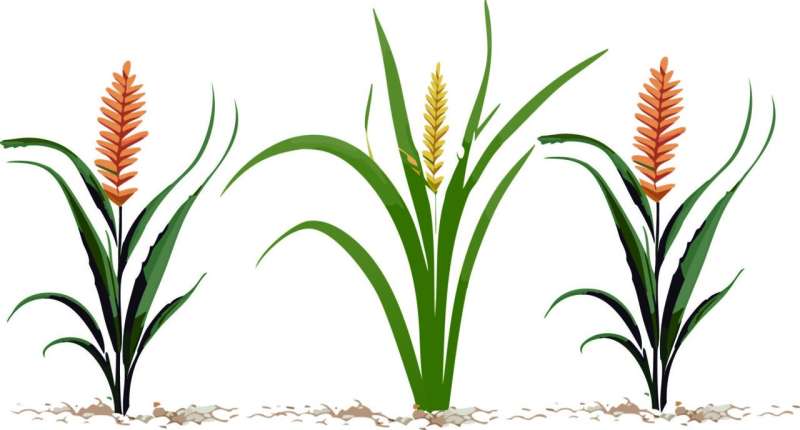This article has been reviewed according to Science X's editorial process and policies. Editors have highlighted the following attributes while ensuring the content's credibility:
fact-checked
peer-reviewed publication
trusted source
proofread
Making crops colorful for easier weeding by robots

To make weeding easier, scientists suggest bioengineering crops to be colorful or to have differently shaped leaves so that they can be more easily distinguished from their wild and weedy counterparts. This could involve altering the crops' genomes so that they express pigments that are already produced by many plants, for example, anthocyanins, which make blueberries blue, or carotenoids, which make carrots orange. Then, they say, weeding robots could be trained to remove only the weeds using machine learning.
The authors outline their proposed strategy in the journal Trends in Plant Science.
"To improve the recognition of weeds, we propose using gene editing techniques to introduce traits into de novo domesticated crops that will allow for visual recognition of the crops by weeding robots that have been trained by machine learning," write the researchers, led by plant and environmental scientist Michael Palmgren of the University of Copenhagen.
"This sustainable approach to eliminating wild analogs in the field combines the potential of genome editing with the power of artificial intelligence and, in principle, could also be used for already established crops."
Humans domesticated crops over the course of thousands of years via meticulous selection and breeding. Thanks to genetics, we now know many of the genes responsible for the desirable traits that our ancestors selected for, which means that new or "de novo" crops could be domesticated much more rapidly by using bioengineering techniques such as gene editing to alter or introduce these traits into wild plants. Since many wild plants are more tolerant to environmental stressors than existing crop species, this could also help create more climate change-resilient crops.
"The ultimate objective is to cultivate a novel range of crops that are environmentally sustainable, high-yielding, and conducive to eco-friendly agricultural practices," the researchers write.
However, de novo domesticated crops are likely to closely resemble their wild counterparts, which would make weeding challenging. One option would be to introduce herbicide resistance genes into the de novo crop and then use herbicides to kill the weeds. Instead, the researchers suggest pairing genetic engineering with AI technologies to create visually distinctive de novo crops plants that robot weeders can easily differentiate from weeds.
"Distinguishing these new crops from their less productive and closely related wild plants could present tremendous challenges for weed control," the researchers write. "Utilizing gene editing to enhance their visual recognition by weeding robots could effectively address this issue."
Rather than introducing non-plant genes (transgenesis) into the de novo crops, the researchers propose altering the plants' genomes so that they express pigments that are already produced by many plants—for example, anthocyanins, which are responsible for red, purple, and blue plant in plants including berries and purple cabbage, and carotenoids, which are responsible for yellow, orange, and red hues of various plant parts including carrots, peppers, and leaves, where they are important for photosynthesis.
"Manipulating these pivotal genes would significantly enhance the accuracy of discriminating between newly domesticated crops and their wild counterparts," the researchers write.
As well as enabling visual discrimination, these pigments could have additional benefits for plant and human health. Anthocyanin accumulation in plants is associated with greater resistance to herbivory, fungal diseases, bacterial infections, heavy metal toxicity, and other environmental stresses, while carotenoids are a source of provitamin A in the human diet.
"Due to these beneficial traits, anthocyanin-rich plants offer not only a straightforward way to distinguish domesticated crops from weeds but also hold promise for practical applications in agriculture," the researchers write.
An alternative (or supplementary) option would be to alter the leaf structure of de novo crops to make them more or less complicated than their wild counterparts—for example by inducing mutations in the genes that add or remove leaf lobes. And to facilitate seed sorting post-harvest, de novo crops could be created to have a different seed color or shape.
More research is needed to examine whether these changes would impact the crops' vitality, for example, to test whether these pigments interfere with photosynthesis or plant resilience. Additional studies are also needed to improve remote sensing techniques and to investigate the best methods for training weeding robots to recognize the de novo crops' new traits.
More information: De novo domestication: what about the weeds? Trends in Plant Science (2024). DOI: 10.1016/j.tplants.2024.03.001. www.cell.com/trends/plant-scie … 1360-1385(24)00057-8
Journal information: Trends in Plant Science
Provided by Cell Press




















